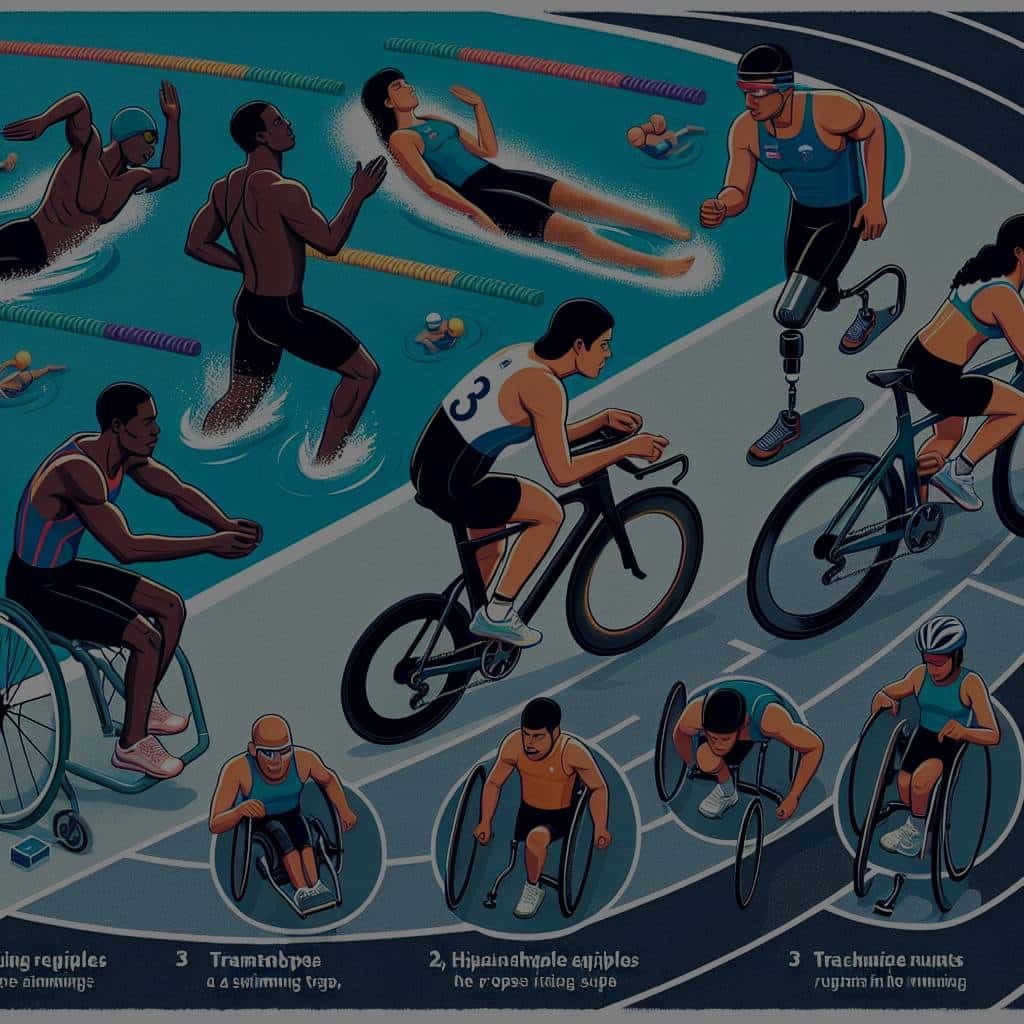How Do Paratriathletes Train for the Three Disciplines Simultaneously?

This article seeks to shed light on the fascinating world of triathlon training, particularly focusing on paratriathletes. Training for a triathlon is a demanding task, requiring athletes to excel in three sports: swimming, cycling, and running. But how do paratriathletes, who may be dealing with physical disabilities, accomplish this monumental task? This article will explore how these athletes train for the three disciplines at the same time, focusing on various aspects such as endurance, distance, time management, performance, and more.
The Demands of Triathlon Training
Before we delve into the specifics of paratriathlon training, it’s essential to understand the demands of triathlon training. A triathlon is a multi-sport race, which consists of three disciplines: swimming, cycling, and running. The athletes must complete these disciplines in succession, making it an endurance sport that tests an athlete’s will, stamina, and mental fortitude.
A lire en complément : Can High-Intensity Interval Training Enhance Endurance in Competitive Rowers?
The distances for each discipline vary depending on the type of triathlon. For instance, in an Olympic distance triathlon, athletes swim 1.5 kilometers, bike 40 kilometers, and run 10 kilometers. This means an athlete needs to be proficient in all three disciplines and be able to transition between them swiftly, as the clock doesn’t stop until the race is over.
Triathlon training, therefore, requires a focus on all three disciplines, often with multiple sessions in a day. Training schedules are typically divided into swim, bike, and run workouts, with additional sessions for strength and conditioning. The workouts themselves are a mix of endurance, speed, and technique sessions, each designed to enhance performance in the respective discipline.
Sujet a lire : How to Tailor Rehabilitation Exercises for ACL Recovery in Women’s Football?
Training Principles for Paratriathletes
Paratriathletes are athletes who have a range of physical disabilities. Despite these challenges, paratriathletes train and compete in the same three disciplines as other triathletes. However, their training might differ slightly, as they need to adapt to their specific needs and abilities.
Google Scholar and PubMed, trusted sources for scholarly literature, provide insights into the training principles that are key for paratriathletes. According to a study published in the Journal of Medicine and Science in Sports and Exercise, paratriathletes need to adapt their training based on their disability. This means that their training sessions might look different from those of regular triathletes.
Another critical factor for paratriathletes is equipment modification. Equipment that caters to their specific needs can help them train more effectively and safely. For instance, handcycles and tandem bikes are commonly used in the cycling discipline, while running prosthetics are used in the run discipline.
Importance of Endurance in Training
Endurance is a key aspect of triathlon training. Long-distance sessions aim to improve an athlete’s ability to sustain effort over an extended period. Endurance is especially crucial in triathlons, as athletes must perform at their peak across three disciplines.
For paratriathletes, endurance training might look quite different. For example, an athlete with a leg amputation might focus on upper body endurance during the swim discipline. Likewise, an athlete with a spinal cord injury might focus on arm endurance during the cycling and running disciplines.
Balancing Volume and Intensity
Just as important as endurance is the balance between volume (the total amount of training) and intensity (how hard the training is). This can be a complex task; training too hard can lead to overtraining and injury, while not training hard enough can result in suboptimal performance.
For paratriathletes, the balance between volume and intensity is even more crucial. They need to consider their specific disability and how it affects their ability to train. For instance, an athlete with a spinal cord injury might need to balance the volume and intensity of their upper body workouts to avoid overuse injuries.
The Role of Technology in Training
Technology plays a significant role in modern-day sports training, and paratriathletes are no exception. They use a range of technologies, from wearable devices that track heart rate and sleep patterns to software that analyzes performance data.
These technologies can be particularly useful for paratriathletes, as they provide valuable insights into their training. For example, a heart rate monitor can help an athlete monitor their intensity during a workout, ensuring they don’t push too hard and risk injury.
In conclusion, paratriathletes train for the three disciplines of triathlon in a similar manner as other triathletes, but with adaptations based on their specific needs and abilities. Their training involves a focus on endurance, a balance between volume and intensity, and the use of technology to monitor and enhance performance. Despite the challenges they face, these athletes exemplify grit, determination, and the will to overcome obstacles.
Implementing a Holistic Approach in Training
In triathlon training, it’s not just about the physical aspect; the mental and emotional facets are equally crucial. This is particularly true for paratriathletes who face additional challenges due to their disabilities. A holistic approach, encompassing physical, psychological, and emotional training, is key to success.
According to a study cited on Google Scholar and PubMed, successful paratriathletes tend to use psychological strategies such as goal setting, mental imagery, and self-talk. They focus not just on their physical abilities but also on their mental toughness, resilience, and determination. They often work with sports psychologists to enhance their mental strength and to handle the psychological demands of the sport.
In addition, paratriathletes also emphasize recovery and nutrition. They understand the importance of rest days in preventing overtraining and promoting muscle recovery. They also know the value of a balanced diet in providing the necessary energy and nutrients for training and recovery.
Furthermore, social support is deemed vital in a paratriathlete’s journey. Support from family, friends, coaches, and fellow athletes can be a significant source of motivation and encouragement. This aspect underscores the fact that triathlon, while an individual sport, is really a team effort.
Addressing Injuries and Ensuring Safety
Injuries can be a significant setback for any athlete, and paratriathletes are no exception. In fact, they may be at a higher risk of injury due to their disabilities. Therefore, injury prevention and safety measures are integral parts of their training.
According to PubMed and CrossRef, common injuries in paratriathletes include those related to overuse, accidents, and falls. Therefore, paratriathletes need to ensure safe training environments, proper technique, good equipment, and adequate rest to prevent these injuries.
Moreover, medical and physical therapy support is often an integral part of the training regimen for paratriathletes. Regular consultations and check-ups can help detect and address potential issues early. Physical therapy can also help improve mobility, strength, and flexibility, which can enhance performance and reduce the risk of injury.
Conclusion
Training for a triathlon is a monumental task, and even more so for paratriathletes. They face unique challenges due to their disabilities, but they do not let these challenges hinder them. Instead, they adapt their training to suit their specific needs and abilities, demonstrating extraordinary resilience and determination.
They follow a holistic approach, focusing on physical, psychological, and emotional aspects. They use technology to monitor and enhance their performance, and they place a high value on recovery and nutrition. They also recognize the importance of addressing injuries and ensuring safety in their training.
Paratriathletes exemplify what it means to overcome obstacles and push the boundaries of what is possible. They remind us that with the right mindset, proper training, and unwavering determination, one can achieve extraordinary feats. Their stories are a testament to the human spirit’s power and resilience, inspiring us all to strive for our goals, no matter how daunting they may seem.
